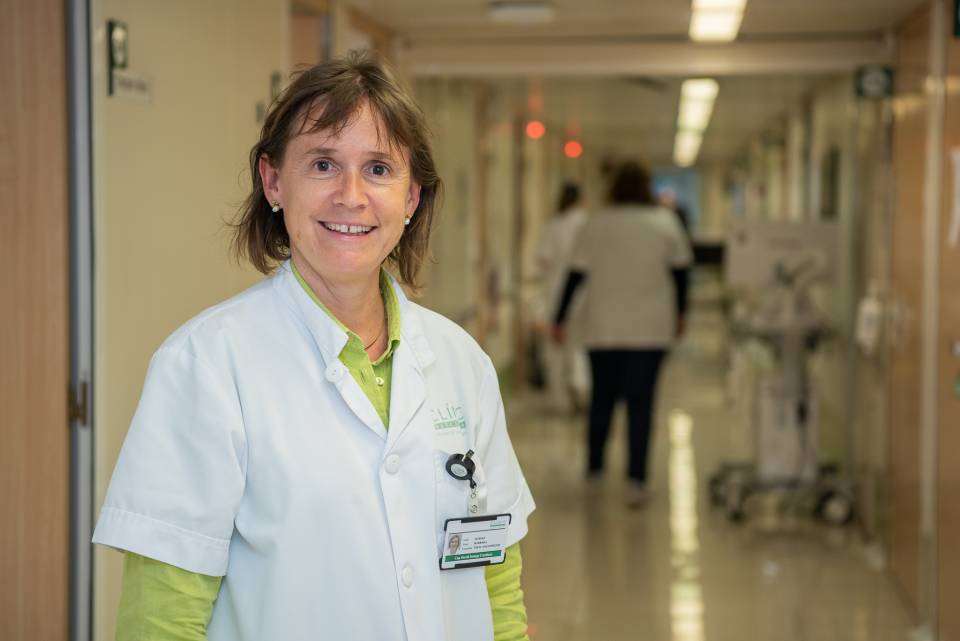What is aortic valve stenosis?
AVS is a valvular heart disease. The valves are like floodgates that keep the blood flowing in the correct direction within the heart chambers. When the aortic valve becomes calcified (it is not known exactly why this occurs), its opening becomes narrower, which makes it hard for the blood to leave the heart, and the capacity to exert effort is reduced. If the disease is not diagnosed and we allow it to evolve, the patients will progressively become more tired after very little effort, and even have breathing difficulties upon the slightest exertion or even when resting. Moreover, there are less frequent symptoms such as feeling dizzy and fainting, especially during exertion, and also chest pain.
So, diagnosing the disease early is of key importance, is it?
Yes, exactly. Diagnosing the disease allows us to start the treatment early and, in short, this means that the patient will have a better quality of life for longer.
Whilst the aortic valve stenosis is not severe, the treatment is medical with periodical echocardiographic assessments. On the other hand, when the disease is severe and symptoms appear, we have to decide how to treat the aortic valve. In some patients, we have to perform surgery, which involves opening the sternum and replacing the aortic valve with a prosthesis. In other patients, the treatment is percutaneous and transcatheter aortic valve implantation (TAVI) is performed through the femoral artery.
Which criteria determine the kind of treatment that should be given?
What we know for sure, as a result of many years of experience and thousands of patients treated, is that aortic valve replacement surgery is a very effective treatment for these patients. Therefore, as long as there are no contraindications, this is the treatment of choice. However, in the patients with a high surgical risk, or who are elderly and more fragile, we choose percutaneous treatment, which has also been shown to work very well. Moreover, due to the characteristics of some patients, it may not possible to carry out surgery or the percutaneous treatment, and therefore we need to opt for pharmacological treatment.
How does the patient’s condition evolve after treatment?
When a patient is diagnosed in time, and undergoes surgical or percutaneous treatment, the recovery is very good and they will even be able to start playing sports again.
So, is it true that aortic valve stenosis is a very common disease in the elderly?
More or less. Aortic valve stenosis is more common in the elderly. However, it is also true that there are younger patients and they usually have congenital valvular heart disease, known as bicuspid aortic valve disease, which means the valve deteriorates earlier than usual. We see patients with a wide range of ages.
How many patients do you see each year?
We currently perform surgery on around 200 patients each year, and TAVI on around 100 more. Moreover, in the outpatients department we monitor aortic valve stenosis patients whose condition is still not very severe and are waiting for the best time for treatment. Finally, we also care for patients who, due in general to other medical conditions, are receiving medical treatment, and thus cannot receive more invasive treatments.
The MITMEVA project is currently being carried out. What does it consist of?
The MITMEVA project that we at the Hospital Clínic are leading aims to improve procedures for patients with aortic valve stenosis. We want to try to describe this disease better and inform the general public about it. At the same time, we want to provide tools to the specialists who see patients in primary care, in order to allow them to diagnose this disease early. Another of the project's objectives is to improve the way that the Hospital Clínic de Barcelona interacts with other referral centres, so as to make decisions more quickly and be able to treat patients better. We want the diagnoses to be quicker and the series of diagnostic tests to be carried out more smoothly. It is also very important for the patient to have all the information possible and for them to be able to make decisions throughout the entire process: we must allow them to participate in the decision-making.
What do you hope to improve over the 3 years of the project?
We have lots of work to do. In 3 years’ time, we will have sown the seeds for working in a different way: involving primary care and cardiologists in other centres far more, and we will have greatly improved the establishment of circuits between the professionals concerned. Above all, we will have incorporated the culture of patient participation in the decision-making. In other words, in interventions that entail a risk for the patient, such as surgery or percutaneous treatment, the patient should be able to participate more in making decisions about the best treatment for them.
How can we look after our heart?
Clearly, we need to be aware of our physical limitations. We can’t run a marathon without training, for example. In the case of patients who have never practised sport and are turning 40, it is advisable for a doctor to perform a thorough auscultation, to ask about their symptoms and family history, to perform an electrocardiogram (ECG) and, if possible, an echocardiogram and a stress test. Moreover, it is very important not to smoke and to eat a balanced diet, with salads, pulses, fruit in season, fish and more white meat than red. Avoid fried food and limit your salt intake.
Physical exercise is also an important way of looking after your heart. How much exercise do we need?
Of course, we need to keep active. You don’t have to run 10 km every day; walking briskly for around 30 minutes, for example, is usually enough. Walking 10,000 steps a day is no use unless they are 10,000 consecutive steps. If you have a good diet and take regular exercise, your heart will definitely be stronger!




